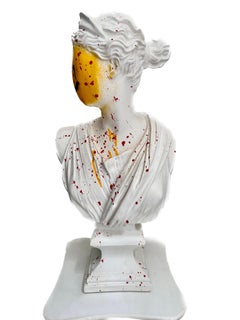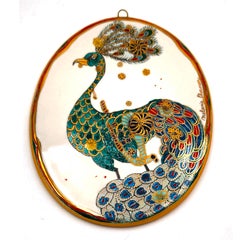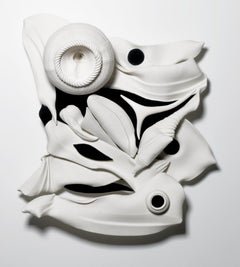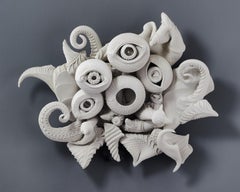Baroque Sculptures
to
10
30
32
13
11
1
5
Overall Height
to
Overall Width
to
6,703
2,875
1,084
823
203
153
134
122
120
72
11
8
7
7
20
12
10
9
8
7
7
6
5
3
2
2
2
1
1
1
1
1
1
1
8
8
5
9
1
3
4
5
4
2
1
1
13
11
10
10
7
Item Ships From: USA
Style: Baroque
"Untitled 2" Sculpture 24" x 11" x 7" inch Edition 1/1 by Isaac Pelayo
By Isaac Pelayo
Located in Culver City, CA
"Untitled 2" Sculpture 24" x 11" x 7" inch Edition 1/1 by Isaac Pelayo
Unique work. Signed by the Artist. Comes with COA.
Hand embellished plaster/fiberglass sculpture
ABOUT THE AR...
Category
21st Century and Contemporary Baroque Sculptures
Materials
Plaster, Fiberglass, Spray Paint
"Untitled 1" Sculpture 23" x 13" x 8" inch Edition 1/1 by Isaac Pelayo
By Isaac Pelayo
Located in Culver City, CA
"Untitled 1" Sculpture 23" x 13" x 8" inch Edition 1/1 by Isaac Pelayo
Unique work. Signed by the Artist. Comes with COA.
Hand embellished plaster/fiberg...
Category
21st Century and Contemporary Baroque Sculptures
Materials
Fiberglass, Plaster, Spray Paint
Laocoön And His Sons Bronze
Located in New Orleans, LA
Laocoön and his Sons
Italian Bronze Group after Agesander, Polydorus and Anthenodorus
Late 18th Century
“The greatest piece of art in the world.”
- Michelangelo, Italian sculptor, p...
Category
Late 18th Century Baroque Sculptures
Materials
Bronze
Vintage Peacock III (Wall Piece/Dish (hand-painted, made to order by the artist)
Located in Kansas City, MO
Melanie Sherman
Vintage Peacock III (Wall Piece/Dish (handpainted)
Porcelain, Glaze, Overglaze, Chinapaints, 24k German Gold Luster, Brass Wire (for hanging, can be removed)
Year: 20...
Category
1790s Baroque Sculptures
Materials
Brass
Charles Birnbaum_Composition Black and White No.2_Porcelain_Maximalist Sculpture
Located in Darien, CT
Charles Birnbaum is a sculptor and a self-taught photographer. He graduated from Kansas City Art Institute where he studied ceramics and was among a select group of the esteemed Ken ...
Category
2010s Baroque Sculptures
Materials
Porcelain, Acrylic
Charles Birnbaum_Wall Piece No.28_Porcelain_Maximalist Sculpture
Located in Darien, CT
Charles Birnbaum is a sculptor and a self-taught photographer. He graduated from Kansas City Art Institute where he studied ceramics and was among a select group of the esteemed Ken ...
Category
2010s Baroque Sculptures
Materials
Porcelain
Vintage Peacock I (Wall Piece/Dish) (MADE TO ORDER) (~50% OFF LIMITED TIME ONLY)
Located in Kansas City, MO
(MADE TO ORDER) (Hand-painted, hand-made, porcelain)
*Lead Time may vary between 1-3 weeks
Melanie Sherman
Vintage Peacock I (Wall Piece/Dish (handpainted)
Porcelain, Glaze, Overglaze, Chinapaints, 24k German Gold Luster, Brass Wire (for hanging, can be removed)
Year: 2022
Size: 4.5x6x0.5in
Signed by hand
COA provided
Ref.: 924802-1330
------------------------
My ceramics are handmade and painted with the finest overglazes from Europe. The gold luster used is 24k liquid Gold from Germany. Every piece is unique. My imagery is inspired by vintage Meissen dinnerware...
Category
2010s Baroque Sculptures
Materials
Brass
Renaissance Era Marble Figure Fragment
Located in Newport Beach, CA
An extraordinary 17th century, hand-carved, solid Carrara marble, life sized figure fragment on raised base of the same. The subject is swaddled in a luxurious, gathered robe and tun...
Category
17th Century Baroque Sculptures
Materials
Marble
Evolution Painted Bronze Sculpture
Located in Rochester Hills, MI
Angelo Basso (Italy, 1943 – 2011)
Evolution
Signed and marked IX / XXXIII
Beauty & Mythology Collection
Sculpture 23″ inches tall
(Base 5″ Siren 18″)
Box size 20″ x 17″ x 27″ ...
Category
1980s Baroque Sculptures
Materials
Bronze
Maqueta las toninas
Located in Miami, FL
Maqueta las Toninas, 1944
BMY-022, 1970
Edition 1/25
Bronze
22 x 22 x 10 cm
8.6 x 8.6 x 3.9 in
ABOUT THE ARTIST
Narvaez was born in Porlamar, Venezuela, in 1905; he was the fifth son of eleven siblings; his parents were Jose Lorenzo Narvaez and Vicenta Rivera. Don José Lorenzo, a multifaceted and creative man, sowed the seed of creativity in his son. “My father did not fit in with his fantasies of cabinetmaker, bricklayer, master builder, and self-taught architect.”1 From an early age, Francis was led to the artistic activity, he traced, carved, made replicas of the furniture and the saints restored by his father.
In 1920 he obtained his first professional assignment, a San Rafael for the Church of Carupano, and, in 1922, his father authorized him to travel to Caracas to pursue his studies as an artist. He studied at the atelier of Marcos Castillo, at of the Angel Cabre y Magriña and at the Academy of Fine Arts in Caracas, where he was introduced to the painters and intellectuals of the time.
In 1928 he presented his first solo exhibition at the Club Venezuela. With the money raised from the sale of the works and the support of Monsignor Sosa, and the Ministers Centeno Grau and Arcaya, he studied in Paris on a scholarship. Once there, he enrolled at the Académie Julian, where Tito Salas, Cristóbal Rojas and Arturo Michelena had also studied. It was in Paris where, unable to work in wood, he turned to stone carving. “In Paris, I didn’t have wood, so I carved a lot in stone (…), when there were demolitions I purchased chunks of stone, I would take them to the workshop and carve them.”2
His first attempts at volumetric sculptures and painting in plain colours, linked to the thematic of American miscegenation and Creole reality, can be traced back to that first trip to Paris. During his stay in the French city, Arturo Uslar Pietri, Alfredo Boulton, and Finita Vallenilla supported the artist both financially and logistically, and in February of 1930, the trio of friends arranged another exhibition for him at the Club Venezuela. Narvaez describes his exhibition as follows: “(…) in it I feel that the sculptural work is more my own, done with more assurance, a response to my pursuit of large planes, stylisation and synthesis.”3 By then, as Boulton himself noted in his book about the artist, Narvaez departed from most of the artistic traditions that prevailed by that time in Venezuela.
In 1931 he returned to Caracas and established his atelier at the Barrio Obrero in Catia. The atelier became the hub of the intellectual life of the time. “In those years, the atelier of Francisco Narvaez was the hub of the greatest Venezuelan hope. Nothing comparable to it can be found either before or since.”4
From that year onwards, exhibitions, projects, trips, and awards we multiplied. He was awarded the President of the Republic of Venezuela Prize, the National Sculpture Prize of the 1st Official Venezuelan Art Salon, and the John Boulton Prize of the 3rd Annual Venezuelan Art Salon; for the Military Academy, he produced a spectacular relief entitled La Patria.
In 1945, commissioned by the architect Carlos Raúl Villanueva, he produced two groups of sculptures known as Las Toninas, both located in the O’Leary Square. There, as he himself states, he incorporates some baroque patterns into the figures to the source itself: “It is a work of balance between the decorative requirements and the sculpture of planes and angles.”5
In 1948 he was awarded the National Painting Prize. In the same year, he was called upon by the architect Carlos Raul Villanueva to participate in the project for the arts integration in the Universidad Central de Venezuela. Francisco Narvaez’s public output continued with works such as the statue of Fermín Toro, La Educacion, La Ciencia, three murals (produced by María Luisa Tovar) for the Instituto de Medicina Experimental, El Cristo; el Atleta, the equestrian statue of General Rafael Urdaneta.
In 1953 he was appointed Director of the School of Plastic and Applied Arts, and in July of the same year, he exhibited “Francisco Narvaez, Maderas, Piedras y Bronces” (Francisco Narvaez, Woods, Stones and Bronzes) at the Museum of Fine Arts.
Narvaez is, unquestionably, one of the great Venezuelan sculptors, his work goes through various stages and interests; as the art world evolves, the artist does not remain in his initial scopes of work. His creations are not imposed by the prevailing trends or fashion but do evolve by experimenting with new materials and interests.
When one peruses the artist’s lengthy list of exhibitions, commissions, and awards, it is worth remembering the Narvaez who embark on his career as a child and who, overcoming obstacles, knew how to make the most of his curiosity. He did not settle for living off his successes. He did not remain stagnant as many creators of his environment did. Narvaez managed to understand the changes in the history of art around him. We must not overlook the fact that Francisco Narvaez is an artist amid all the changes occurring in the art world. He moves from the classics to the great transformations in the art world. It is the Europe of Picasso, Braque, Arp. He observes, he is aware of what is happening in the centres of the world of art, but between his craft and his sensitivity, the result is NARVAEZ, his stamp, and his identity.
Francisco Narvaez comes from tradition, and his first stage is linked to the classics, to the exploration of his heritage, but always with his very own language. Throughout his prolific career, he knew how to remain true to himself, without disregarding the influences of his surroundings or his artistic interests: his ability as a sculptor, his selection of materials, whether they were wood, stone or bronze; his choice of the subject of his work…His mastery and great craftsmanship are a constant that over time have made him a leading player in the history of contemporary Venezuelan and world art.
From his beginnings, no subject was foreign to him. His paintings, drawings, aquarelles, and sketches are testimony to his prolific output. Among his themes are portraits, our traditions, still lifes, and landscapes. Narvaez is an artist who represents his time. Later, he evolved towards purer and simpler forms, abandoning figurative art for short periods.
In 1956 he declared to the newspaper El Nacional: “Every day I am freeing myself, it is a soul that frees itself from the ephemeral wrappings of the circumstantial always, as well as from the inevitable weight of the anecdote. This second stage of my work is remarkably close to abstractionism, even if there are still certain figures or figurations in the sculptures that I will shortly be showing. However, pure, and absolute abstractionism, it will treat the form itself as the sole reason for its existence on the plane of artistic excellence.”6
The artistic development was his professional life. Each period of his life as an artist, he went one step further, searching, solving, seeing plenty of things and understanding how diverse expressions were transforming themselves. His hands followed his gaze and his mind, always inquisitive. He added movement to the volumes.
Arturo Uslar Pietri, “Formas Nuevas”, Cromotip editions, 1956 “Francisco Narvaez is a path: the path that Venezuelan sculpture...
Category
1940s Baroque Sculptures
Materials
Bronze
Life Size Roman Marble Figure
Located in Newport Beach, CA
A beautifully hand carved, full size Carrara marble figure of a boy. The robe is elegantly draped with clasps.
Category
19th Century Baroque Sculptures
Materials
Marble
Carrara Marble Head of a Cherub
Located in Newport Beach, CA
Hand carved Carrara marble head of a cherub's face surrounded by wings. Later mounted on metal base.
Category
Early 19th Century Baroque Sculptures
Materials
Marble, Metal
Laocoön And His Sons By Adriaen De Vries
Located in New Orleans, LA
Adriaen de Vries
1556-1626 Dutch
Laocoön and His Sons
Bronze
A remarkable feat of artistry and skill, this bronze sculpture was created by famed Dutch artist Adriaen de Vries. Full of the swelling emotions and dramatic posing so quintessential to the period, the bronze is a masterclass in Baroque sculpture.
The original Laocoön marble sculpture, after which this remarkable bronze was modeled, unquestionably influenced the lives and works of countless artists, authors, popes, kings and emperors since its re-discovery in 1506. Famously, Michelangelo declared the sculpture, created circa 35 BC, as the “greatest piece of art in the world.” Adriaen de Vries, an apprentice of the great sculptor Giambologna, undoubtedly sought to prove his skill and creative voice with his own depiction of this most famous scene. Known for his virtuosic casting technique, this rare and important sculpture embodies de Vries’ mastery.
The story of Laocoön is one of the most famous in all of literature. As told by the poet Virgil, the Greeks, after an unsuccessful ten-year siege on the city of Troy, the Greeks craftily left a giant wooden horse outside the gates...
Category
16th Century Baroque Sculptures
Materials
Bronze
Bronze of Pluto Abducting Proserpine after François Girardon
Located in New Orleans, LA
After François Girardon
1628-1715 French
Pluto Abducting Proserpine
Bronze
This High Baroque period composition captures the famed narrative of Pluto and Proserpine from Roman mythology. The late 17th-century patinated bronze, created after François Girardon's marble composition, captures the very moment that Pluto seizes Proserpine. The anguished goddess reaches skyward, attempting to escape the god’s grasp while Pluto’s stoic face betrays his knowledge that his ploy will succeed. This pivotal moment in the mythological tale has captured the imagination of many art historical greats, from Bernini to Rubens. François Girardon’s version of the climax demonstrates incredible finesse and artistry, modeled expertly in bronze in the present work by a later sculptor. The statue brings a twist of intertwined bodies into a dynamic frenzy, paralleling the tension of the legendary story.
In ancient Roman mythology, Proserpine, the beautiful daughter of Ceres — known as Persephone in Greek mythology — was picking flowers in the fields when she was suddenly abducted by Pluto, the god of the underworld, and taken to his kingdom. Consumed with grief, her mother Ceres, the goddess of agriculture, scorches the earth, stopping the growth of grain and fruit. Jupiter attempts to intervene and secure Proserpine’s return to earth, negotiating a compromise with Pluto and the Fates that allows Proserpine to be released for part of the year before returning to Pluto’s underworld. Proserpine’s journey back and forth is an allegory for the changing seasons; when Prosperine is with her mother, the earth warms and provides bountiful harvests. Upon her annual return to the underworld, however, the earth once again becomes cold and barren.
After returning to France after years of training in Rome, François Girardon quickly rose to become one of the greatest artists in France. He was elected a member of the Académie Royale de Peinture et de Sculpture in 1657 and would become Chancellor of the Royal Academy in 1695. The artist was approached frequently for royal commissions and Girardon’s Pluto was originally commissioned by Louis XIV for the gardens at his Palace of Versailles. It was one of four monumental marble groups intended to decorate the corners of Charles Le Brun’s never completed garden at the chateau, the Parterre d’Eau. Each group of three figures symbolized one of the four elements: earth, air, fire and water. Pluto’s association with hell made him the apt...
Category
Early 18th Century Baroque Sculptures
Materials
Bronze
Polychrome Carved Mexican Sculpture -- Child Jesus
Located in Troy, NY
This is a hand-carved wood polychromed sculpture of the Infant Jesus. A baroque figure probably from the 18th century, this religious figure was obtained in Mexico. It appears to hav...
Category
18th Century Baroque Sculptures
Materials
Wood, Paint
19th Century French Bacchanalian Bronze
Located in San Antonio, TX
19th Century French Bacchanalian Bronze in the 18th century style depicting two Putti, in the manner of Clodion. One putto reclines while another feeds it grapes. The Patina is worn ...
Category
Late 19th Century Baroque Sculptures
Materials
Bronze
Gabriella Bronze Sculpture
Located in Rochester Hills, MI
Angelo Basso (Italy, 1943 – 2011)
Gabriella
Dimensions 17.0" W x 18.0" H x 7.0" D
This sculpture was cast in the Dyansen Studios Foundry in 1991 under...
Category
1980s Baroque Sculptures
Materials
Bronze
Patinated Bronze Statue of Theseus and the Centaur by Antoine-Louis Barye
Located in New York, NY
Title: Theseus and the Centaur
Artist: Antoine-Louis Barye (1795-1875)
Date: 19th Century
Medium: Oil on panel
Signature: Signed ‘AL BARYE’ and stamped with ...
Category
19th Century Baroque Sculptures
Materials
Bronze
Paolo And Francesca
Located in Rochester Hills, MI
Angelo Basso
Bronze
1989
Paolo And Francesca-
Size: Size: 42 x 12 x 12 in
Signed and marked 92/95
"ITALIAN MASTER OF THE MODERN BAROQUE"
The story o...
Category
1980s Baroque Sculptures
Materials
Bronze
Susanna al bagno Italian Marble Statue by Lombardi with relief sculpture Base
By Giovan Domenico Lombardi Omino
Located in New York, NY
GIOVANNI BATTISTA LOMBARDI (ITALIAN, 1822-1880)
A fine marble statue titled Susanna al Bagno sitting on a revolving pedestal carved in relief with...
Category
Mid-19th Century Baroque Sculptures
Materials
Marble
Yunomi (MADE TO ORDER) (Sabbath, Kiddush, Ceremonial Vessel)
Located in Kansas City, MO
(MADE TO ORDER) (Sabbath, Kiddush, Ceremonial Vessel)
*Lead Time may vary between 1-3 weeks
Melanie Sherman
"Yunomi"
Year: 2021
Porcelain, Glaze, ChinaPaint, 24k German Gold Luster,...
Category
2010s Baroque Sculptures
Materials
Luster, Porcelain, Glaze
Small Vase (MADE TO ORDER) (Hand-painted, hand-made, porcelain)
Located in Kansas City, MO
(MADE TO ORDER) (Hand-painted, hand-made, porcelain)
*Lead Time may vary between 1-3 weeks
Melanie Sherman
"Small Vase"
Year: 2021
Porcelain, Glaze, China...
Category
2010s Baroque Sculptures
Materials
Luster, Porcelain, Glaze
Charles Birnbaum, 372 Wall Piece No.20, 2017, porcelain, 19.5x15.5x7 in, Visionary
Located in Darien, CT
Charles Birnbaum is a sculptor and a self-taught photographer. He graduated from Kansas City Art Institute where he studied ceramics and was one of a select group of the esteemed Ken...
Category
2010s Baroque Sculptures
Materials
Digital Pigment, Porcelain
Charles Birnbaum, 371_Wall Piece No.19_2017_porcelain_19x13x5 in_Visionary
Located in Darien, CT
Charles Birnbaum is a sculptor and a self-taught photographer. He graduated from Kansas City Art Institute where he studied ceramics and was one of a select group of the esteemed Ken...
Category
2010s Baroque Sculptures
Materials
Porcelain
Just A Little Tipsy (MADE TO ORDER) (Sabbath, Kiddush, Unique, Gold Luster)
Located in Kansas City, MO
(MADE TO ORDER) (Sabbath, Kiddush, Unique, Gold Luster)
*Lead Time may vary between 1-3 weeks
Melanie Sherman
"Just A Little Tipsy"
Year: 2021
Porcelain, Glaze, ChinaPaint, 24k Germ...
Category
Late 17th Century Baroque Sculptures
Materials
Luster, Porcelain, Glaze
"Putti" 19th c. Terracotta, Antique, Mythical Figures, Patina
Located in Detroit, MI
SALE ONE WEEK ONLY
“Putti” is a 19th c. terracotta antique of two nude children, babies, as mythical figures. This piece is beautifully rendered with a...
Category
Late 19th Century Baroque Sculptures
Materials
Terracotta, Wood
Bust of Pope Innocent XI Odescalchi by Domenico Guidi
Located in New Orleans, LA
This monumental bust is a museum-quality example of Roman Baroque sculpture. Crafted by the legendary Domenico Guidi and carved from Carrara marble, the impressive portrait captures the visage of Pope Innocent XI, Benedetto Odescalchi (1611-1689). It presents a larger-than-life example of Guidi’s remarkable skill as a sculptor, which ultimately made his workshop one of the most important in Rome during his age. Today, his works are rarely found on the market, particularly his extraordinary works in marble.
Pope Innocent XI was born Benedetto Odescalchi into an Italian noble family of prominent bankers. Spending his early years in banking, he eventually turned to the law, earning his doctorate in 1639. His background would serve him well in his service to the papacy, and he became known as a frugal and devout member of the Church. In 1676, he was unanimously elected Pop after the death of Clement X. During his nearly 13-year reign, he instilled his own personal ideals of austerity and frugality onto the Church, with a deep commitment to reform and piety.
He is captured here by Guidi in his traditional Pope’s mozzetta and camauro cap. A wide stole is draped over his shoulders, ornamented by acanthus leaves and the coat of arms of the Odescalchi family. It displays Guidi’s mastery over the chiaroscuro effect, particularly in the high level of contrast in his cheeks and his eyes, which Guidi achieved through various methods of high polish.
A very similar portrait sculpture of Pope Innocent XI by Guidi can be found in the collection of the Royal Castle in Warsaw. The Warsaw bust belongs to a series of portraits of popes which the Odescalchi family commissioned from Domenico Guidi in the 1690s. Compared to that example, the present bust is far more dramatic, with deeper cut lines and a more precise expression. It is likely that the present piece was seen by the Odescalchi family, who ordered a similar one to be made. The piece was almost certainly intended to be displayed in a niche, given its dramatic cutting and its roughly carved back.
Others of Guidi’s busts can be found in important collections throughout Italy, England and the United States, though many of these are lesser bronze repetitions. A bronze bust of the Pope Alexander VIII by Guidi is currently in the collection of the Victoria & Albert Museum (London), while a terracotta version of the same is in the Los Angeles County Museum. A bronze of Pope Alexander VIII can be found in the Princely Collection of Lichtenstein, and his impressive marble papal bust of Clement IX graces the pope’s tomb in Santa Maria Maggiore. The present bust of Pope...
Category
17th Century Baroque Sculptures
Materials
Marble
Pair of 19th Century Busts by Albert Ernest Carrier-Belleuse
Located in Santa Fe, NM
Signed: A. Carrier-Belluese
Two large bronze matching busts of an unknown male and female
22 x 10 x 11" male
23 x 10 x 9" female
Both show signs of wear with their age but are in fa...
Category
19th Century Baroque Sculptures
Materials
Marble, Bronze
Vintage Cobalt Blue and Gold Trim Limoges Porcelain Trinket Box France
Located in East Quogue, NY
Beautiful vintage cobalt blue lidded porcelain trinket jewelry box with gold hand-painted floral decorative rim. The central illustration is of a couple dressed in Louis XVI period s...
Category
Mid-20th Century Baroque Sculptures
Materials
Porcelain, Ceramic
Rare and Important Italian Alabaster Bust Sculpture of Jesus Christ, C. 1860
Located in New York, NY
A rare and important Italian alabaster bust sculpture of Jesus Christ, C. 1860
A modeled bust of Holy Christ wearing a crown of thorns, exceptional...
Category
19th Century Baroque Sculptures
Materials
Alabaster
Baroque sculptures for sale on 1stDibs.
Find a wide variety of authentic Baroque sculptures available for sale on 1stDibs. Works in this style were very popular during the 21st Century and Contemporary, but contemporary artists have continued to produce works inspired by this movement. Many Pop art paintings were created by popular artists on 1stDibs, including Albert-Ernest Carrier-Belleuse, Antoine-Louis Barye, and Giovan Domenico Lombardi Omino. Frequently made by artists working with Stone, and Marble and other materials, all of these pieces for sale are unique and have attracted attention over the years. Not every interior allows for large Baroque sculptures, so small editions measuring 9 inches across are also available. Prices for sculptures made by famous or emerging artists can differ depending on medium, time period and other attributes. On 1stDibs, the price for these items starts at $1,140 and tops out at $138,000, while the average work sells for $7,834.
Recently Viewed
View AllMore Ways To Browse
Fruit Figurines
Outdoor Sculpture Art Deco
Outdoor Hanging Sculpture
Contemporary Wearable Art Jewelry
Bronze Airplane
Ancient Views Of Shanghai
Nu Sculpture
Samurai Cat
Japanese Cat Figurine
Minotaur Sculpture
Emergency Glass
Panda Sculpture
Noguchi Stone
Raw Minerals
Lee Bontecou
In Case Of Emergency
Abstract Bronze Sculpture Netherlands
Red Panda





